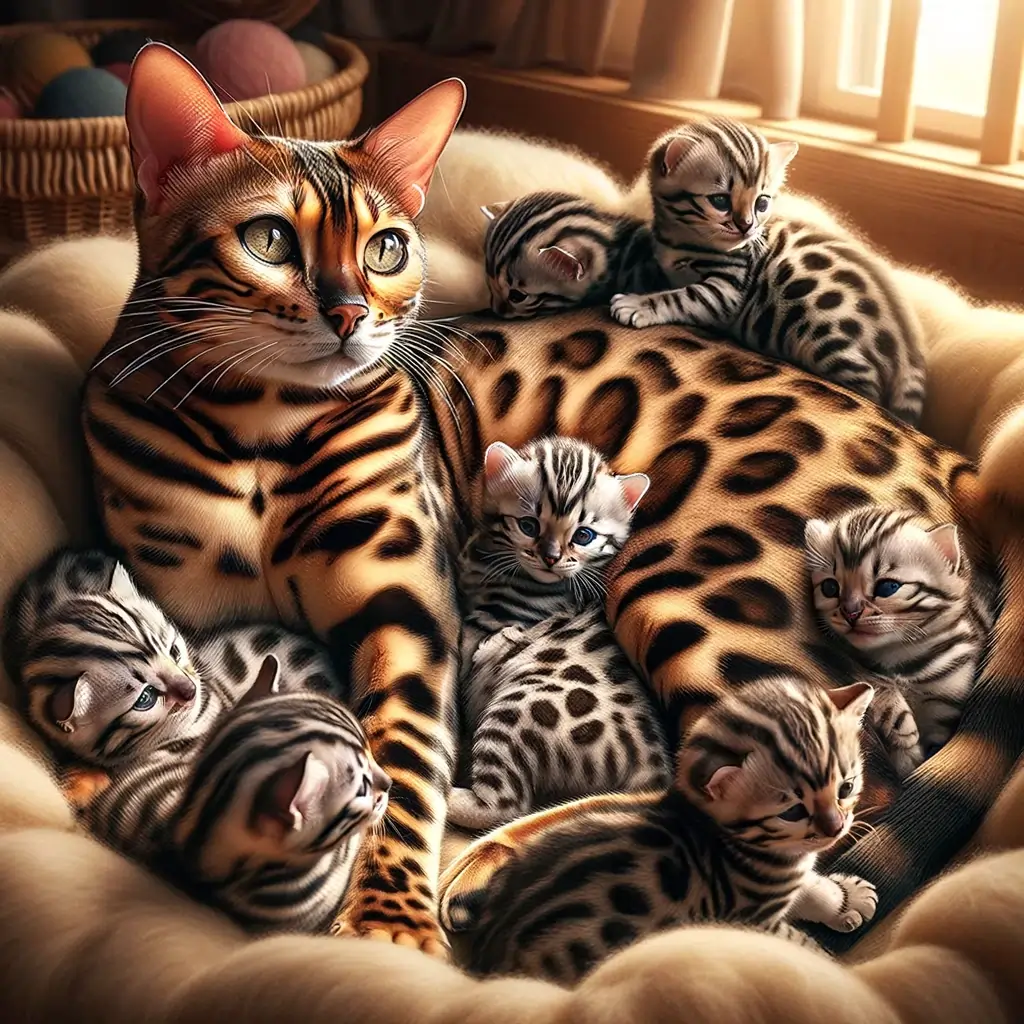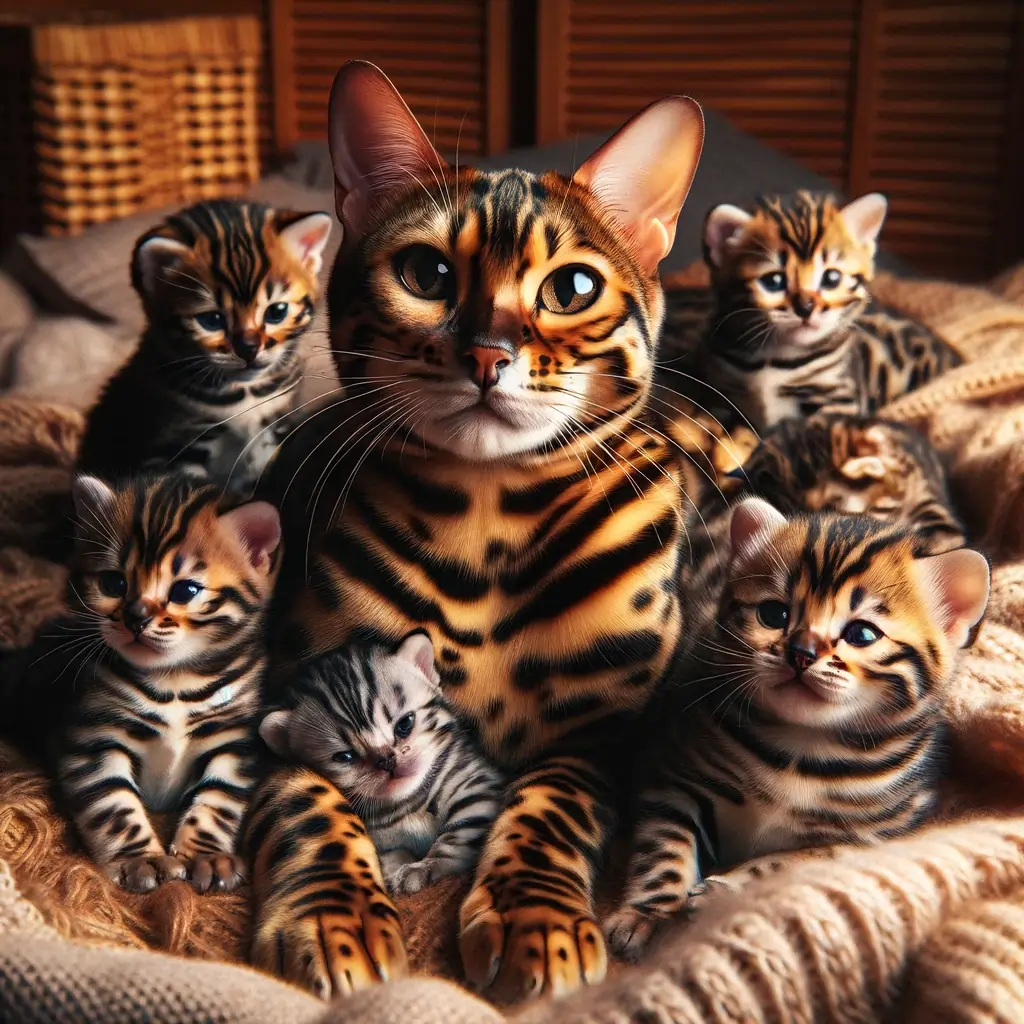If you’ve ever been mesmerized by the wild allure of Bengal cats, with their striking markings and vivid personalities, you might have found yourself curious about every aspect of their lives, especially when it comes to their offspring. Bengal cats, a breed that descends from a mix of domestic cats and the Asian leopard cat, hold a special place in the hearts of many.
So, let’s dive deep into the fascinating world of Bengal cat litter, uncovering everything from the average litter size to how you can best care for these majestic creatures during pregnancy.
What Determines the Average Litter Size for Bengal Cats?
Understanding the litter size of Bengal cats involves peering into the genetic blueprint of the breed. Fundamentally, the Bengal inherits traits from both its wild ancestors and domestic cat relatives. This genetic mix can influence litter sizes significantly.
Typically, Bengal cats can bear litters that vary in number, largely depending on their heritage. Breeders consider the generational differences, with F1 and F2 generations (those closer to their wild ancestors) sometimes producing smaller litters than their fully domesticated counterparts.
Understanding the Impact of Age on Feline Fertility
The age of a female Bengal plays a crucial role in her fertility and, subsequently, the size of the litter she can produce. Younger female Bengals may bear smaller litter in their first few heats, but as they mature, the size of the litter can increase. However, it’s important to note that there’s a tipping point; as a Bengal cat ages, her fertility can decrease, leading to smaller litters once again. This bell-curve pattern of fertility is something breeders and Bengal cat republic enthusiasts keenly observe.
The Role of Health and Care in Reproduction Success
Aside from genetics and age, the overall health and care of a mother Bengal profoundly impact her ability to have a successful, healthy litter. A well-nourished, stress-free environment can contribute to larger, healthier litters. Conversely, Bengals living in less-than-ideal conditions might have trouble conceiving or bearing as many kittens. Regular vet checks, a balanced diet, and a safe birth environment are key contributors to the reproductive success of Bengal cats.
How Many Kittens Can You Expect in a Bengal Cat Litter?
When we talk about averages, Bengal cats typically produce litters of 3-5 kittens. This number, of course, can depend on several factors like health, age, and whether you’re breeding Bengals closer to their wild roots (F1, F2 generations) or more domesticated ones. Depth of research, breed knowledge, and sometimes a bit of luck contribute to the expectations of a litter’s size.
Variations in Litter Size: From Smaller to Larger Litters
Litter sizes can indeed vary from one Bengal to another. Factors such as the cat’s birth size, her age, and her health status play into this. Some Bengals may produce as few as two kittens in a litter, especially in the F1 and F2 generations, while others may surprise their owners with litters of six or more. Tracking the litter history of the mother Bengal can sometimes offer a clearer estimation of future litters.
Case Studies: Real-Life Bengal Litter Sizes
Real-life cases have shown a wide range of outcomes when it comes to Bengal cat litters. For instance, a first-time mother Bengal might bear a smaller litter of three kittens, only to produce five or six in subsequent pregnancies as her body becomes fully accustomed to the birthing process. Breeders often share stories of particularly large or small litters, evoking both the challenges and joys of breeding Bengal cats and the unpredictable nature of feline reproduction.

Caring for a Pregnant Bengal Cat: What You Need to Know
Supporting a pregnant Bengal cat starts long before the kittens’ arrival. Predetermined vet visits, a nutritious diet, and creating a calm birthing environment are pivotal. Breeders and pet owners alike need to prepare for the possibility of a larger litter by ensuring there are enough resources and space for the mother and her kittens. Understanding the stages of pregnancy and recognizing signs of labor are essential skills for anyone caring for a pregnant Bengal.
Understanding the Stages of Bengal Cat Pregnancy
Pregnancy in Bengal cats, as in other breeds, goes through several defined stages, lasting approximately 64 to 67 days. Being able to recognize these stages, including the initial signs of heat, the visible changes in the female’s body, and the behavioral shifts as she approaches birthing, is critical. Use methods like ultrasound to determine pregnancy and monitor the kittens’ development, ensuring the health of the mother and her offspring.
When to Consult a Vet During Your Bengal’s Pregnancy
Consulting with a vet throughout your Bengal’s pregnancy is not only a precaution but a necessity. Early prenatal checks can help ensure the mother cat’s health and ascertain the litter size through methods like ultrasound. Knowing when to seek immediate medical attention, especially during birthing complications, can save the lives of both the mother and her kittens. Regular monitoring and professional advice are paramount in navigating the complex terrain of Bengal cat pregnancy.
The Unique Aspects of Bengal Cats’ Reproduction: F1, F2, and Beyond
The generational tags assigned to Bengal cats, such as F1 and F2, are more than just identifiers; they reveal a lot about the reproductive characteristics and challenges of breeding Bengals. The closer the generation to the wild Asian leopard cat, the more unpredictable and challenging the breeding process can become. These early generations may produce fewer kittens per litter, but each kitten often requires extra care and attention due to their unique genetic makeup.
How Breed Generation Impacts Litter Size and Bengal Kitten Care
As mentioned, the generational distinction has a direct impact on litter size and the intricacies of caring for Bengal kittens. F1 and F2 generations may need more intensive monitoring and care, both during the pregnancy and after the kittens are born. Understanding the specific needs of these early-generation Bengals is crucial for breeders who aim to maintain the breed’s health and characteristics.
The Challenge of Breeding Bengal Cats: Considerations for Breeders
Breeding Bengal cats, while rewarding, comes with its set of challenges. From ensuring the health of the pregnant Bengal to caring for potentially vulnerable newborn kittens, breeders must navigate a complex set of variables.
Ethical considerations, such as the welfare of the mother and kittens and the preservation of the breed’s best qualities, are at the forefront of a responsible breeder’s mind. Realizing that each Bengal cat, and each litter, will bring unique challenges and joys is part of the adventure of breeding these stunning creatures.
Ensuring the Health and Well-being of a Bengal Cat Litter
Best Practices for Taking Care of Newborn Bengal Kittens
Once the kittens arrive, the journey is far from over. Ensuring that each kitten thrives involves regular vet checks, proper nutrition, and socialization. Monitoring the kittens’ development closely for the first few months is key to identifying and addressing any health issues early. The fulfilling journey of seeing Bengal kittens grow, play, and develop their distinct personalities makes all the efforts and challenges worth it.
How to Determine if a Bengal Kitten is Healthy and Developing Properly
Determining the health and development of Bengal kittens involves careful observation and knowledge. Healthy kittens should display steady weight gain, be active and curious, and reach developmental milestones at the appropriate times. Consultation with a vet for regular health checks and vaccinations is essential in ensuring that each Bengal kitten grows up to be a strong, healthy adult cat.
The Importance of Early Vet Visits for Bengal Litter Health Checks
Early and regular vet visits are crucial for maintaining the health of a Bengal litter. Such visits enable the vet to check for congenital issues, ensure that the kittens are developing as expected, and start the kittens on their vaccination schedules. Education on the proper care of Bengal kittens, from diet to socialization, is also a vital part of these visits, providing breeders and new owners with the tools they need to ensure the kittens’ health and happiness.

Hey guys, My name is Simon Smith. I’m from Canada and live near Victoria
I live with my sweet family and have 20+ Ragdolls of different types. I love them as my own children. My profession is as a hotel manager.
I love to keep Ragdolls and grow their breeder case. I have 7 years of experience.
I’m an expert in cat care. So, I’m here to provide you with new information about my cats daily. This is my personal blog website, so I request that you kindly visit our site daily.
If you’re a Ragdolls lover and you have any questions or confusion about cats, text me on the Contact Us page or Gmail.
Thank u
